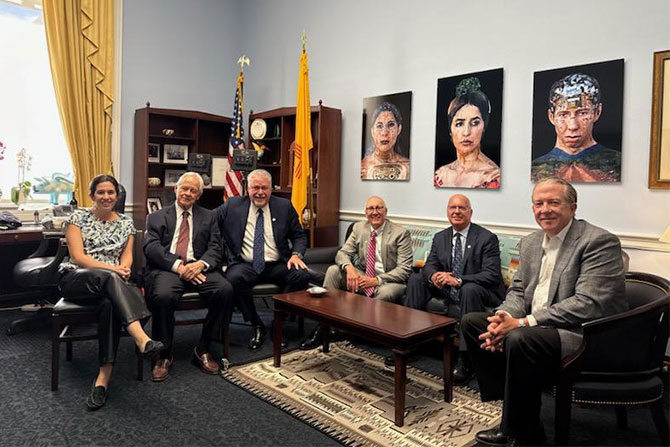‘Somewhere along the way, someone’s going to give you a chance. And then at that point, it’s up to you.’
A quarter century ago, Sociologist Robert Putnam published “Bowling Alone.” The unlikely blockbuster explored the falloff in civic engagement and community involvement in the latter half of the 20th century — illustrated through the decline of bowling leagues despite increases in bowling.
While Putnam’s book has been much discussed and dissected since it was published, at least one bank leader has been quietly using bowling to build community.
Ken Clayton is a lifelong bowler, starting by working as a pinsetter at a local alley. “I grew up in western Pennsylvania in the wintertime,” he chuckles. “There’s not a whole lot to do.”
Clayton took to the sport, eventually joining the professional circuit in the 1990s, playing everywhere from Los Angeles to Niagara Falls. He bowled his first perfect game in 1992 and has scored 300 on 27 occasions since then. “But you have a couple of kids, and you realize that you might not want to make a living throwing a bowling ball,” he says.
By then, he had relocated to the warmer climes of southern New Mexico, and that was where another opportunity to make his mark emerged. Clayton was working in insurance and at a bowling alley, but he credits Joe Mangum, the former CEO of SunWest Bank in Roswell, with giving him a start in banking.
In 1988, Mangum invited Clayton to “really step into a career I knew nothing about. I never had the opportunity to go to college, and I didn’t know anything about banking. He said, ‘I can teach you that.’ And two weeks later, I was a banker.” SunWest didn’t have a management training program. “I said, ‘What am I going to do here?’ And he said, ‘Whatever you want to.’ So I literally spent as much time as I wanted to in each department until I learned it.” Clayton went on to lead the real estate lending area, then moved on to another bank to work on commercial lending.
In 1998, Clayton had an opportunity to join Western Bank in Artesia, a small town south of Roswell, where he’s been ever since. He became president of Western Bank in 2003, and in 2020, he became chairman and CEO.
Together, We Can Make Something Different
Artesia is an oil and gas town in New Mexico’s part of the Permian Basin, the nation’s most productive oil patch. “We’re strong in oil and gas lending,” says Clayton. “We’ve had our same customers forever — a lot of service companies. And they have been there through generations themselves. The families that started the oil business there in the ‘30s are still there and support the schools and the kids tremendously.”
The bank is deeply involved in education, sponsoring scholarships and providing instruction in the local schools. “In a town our size, especially from a banker’s point of view, you can see the results of what you’re really doing every day.”
With 22 employees in a single location at Western Bank, compliance is everyone’s business — literally. “I do the lending side and my CFO does the operations side,” says Clayton. “So it’s not something pushed down to a different department. We are a department.”
As a result, Clayton knows exactly what he speaks of when he discusses the compliance burdens banks like his face. “It goes back to common sense,” he says. “And sometimes I think, wait a minute, that doesn’t line up. We’re trying to fix something that’s not broken.”
Case in point: Section 1071 of the Dodd-Frank Act, which requires reporting of data on small business loans in a way that experts expect will require more standardization and less customization of these loans for unique clients. “Not everybody fits in that box,” Clayton says. “We all have examples in our career of that customer that sat across from you who didn’t exactly qualify, but it felt right and looked right, and you liked it, and you made it, and it worked.” Limiting choices through overreaching rules like 1071 “limits the opportunity for the banker to be a banker,” he says. “You’re limiting the economic opportunity.”
Seeing challenges like 1071 and others up close has gotten Clayton involved in banking affairs at the state level, as president of the New Mexico Bankers Association, and at the national level as a member of ABA’s Community Bankers Council and chair of the Government Relations Council.
He notes that a lot of the issues ABA advocates for aren’t intended to affect Western Bank — but they do. “Things like that trickle down,” he explains. “If you can do something better for your customer, why would you try to hinder that? So that part of my brain just says, ‘Hey, together we can make something different.”’
As for what he’s excited about in 2025, Clayton points to opportunities on tax reform — “Subchapter S in a community bank is huge.” He also points to the Access to Credit for the Rural Economy (ACRE) Act, which reached record levels of bipartisan support in 2024 and will be reintroduced in 2025, opportunities to help “mission-driven banks” and new efforts to tackle fraud.
New Mexico was an early adopter of recreational cannabis use, so the SAFER Banking Act is a priority for Clayton as well. “We have a dispensary in our town. Their sales in a town of 15,000 would blow your mind. And it’s not safe — who knows where their money’s going?”
An Opportunity to Mentor
Clayton’s vision for creating a strong community extends beyond the walls of the bank. Eighteen years ago, the superintendent of schools in Artesia paid Clayton a visit to his office. New Mexico had added bowling as a varsity sport — and Artesia wanted to try it out. “Before he left my office, I was the bowling coach.”
Every year, Clayton coaches a squad of 30 kids — most of whom have never picked up a bowling ball before they join the team; given Artesia’s remote location and the size of the state, competing requires a major commitment. One recent Saturday, Clayton loaded 37 kids onto a bus at 6:30 in the morning. They drove 252 miles, bowled for five hours, then drove 252 miles home, not getting back until midnight.
Clayton has coached the team to nine state championships; this year, Artesia High School was No. 2 in the state tournament. “But my saying is: ‘If all I do is teach them to bowl, I failed miserably,’” he says. “It’s an opportunity to mentor. I have a list I keep in my desk of the 249 kids I’ve coached over 18 years. In a town our size, you can keep track of those kids. We’ve sent kids to college on bowling scholarships to further their education.”
He also points to his own life as an example of what a hardworking kid can do when a mentor offers an opportunity. “That’s what I tell the kids that I get to talk to,” he reflects. “I say, ‘Somewhere along the way, someone’s going to give you a chance. And then at that point, it’s up to you.’ Fortunately for me, I was able to step into something I’ve loved for 36 years.”








